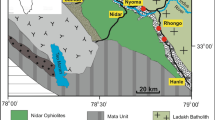Abstract
Pyrite and arsenopyrite are the predominant ore minerals in the Korean Au-Ag deposits of this study. The X pyNi , X pyCo , X apyNi , and X apyCo values range between 100 and 3,000 ppm, 200 and 6,000 ppm, 200 and 8,200 ppm, and 100 and 10,200 ppm, respectively. Most X pyNi /X pyCo values fall in the field lower than values varying 0.16–1.30. Arsenopyrite also tends to prefer cobalt rather than nickel showing X apyNi /X apyCo values between 0.20 and 1.40. The concentrations of minor elements in ores and gangue minerals vary 1–55 ppm Au and 1–1,120 ppm Ag for the former and 4–57 ppm Ni and 2–45 ppm Co for the latter. The Au/Ag ratio in ore has a good correlation to the Ni/Co ratio of arsenopyrite to gangue. The (Ni/Co)py-(Ni/Co)gangue and (Ni/Co)apy-(Ni/Co)gangue diagrams revealed that the values from the Korean Au-Ag deposits plot in the field lower than 900 °C which is the lowermost temperature determined by previous partitioning experiments.
Similar content being viewed by others
References
Abe, H.: Chemical composition of gold ores and Ag/Au values of electrum from the Oya mine, Miyagi Prefecture. Mining Geol. Spec. Issue No. 10:119–129 (1981)
Gralia, A., Sabatini, G., Tvoja, F.: A reevaluation of the Co/Ni ratio in pyrite as geochemical tool in ore genesis problems. Mineral. Deposita 14:353–374 (1979)
Gallagher, D.: Mineral resources of Korea. Issued by Mining Branch, Industry and Mining Div. In Cooperation with Geol. Surv. Republic of Korea. 118 p (1963)
Gammon, J.B.: Some observations on minerals in the system CoAsS-FeAsS. Norsk. Geol. Tidsskv. 46:405–426 (1966)
Ghosh-Dastidar, P., Pajari, G.E., Trembath, L.T.: Factors affecting the trace elements partition coefficients between coexisting sulfides. Econ. Geol. 65:815–837 (1970)
Goldschmidt, K.M.: Geochemistry. London Oxford Univ. Press. 730 p (1954)
Graterol, M., Naldrett, A.J.: Mineralogy of the Marbridge No. 3 & No. 4 nickel-iron sulfide deposits. Econ. Geol. 66:886–900 (1971)
Hawley, J.E.: Spectrographic studies of pyrite in some eastern Canadian gold mines. Econ. Geol. 47:260–304 (1952)
Hawley, J.E., Nickol, I.: Trace elements in pyrite and pyrrhotite. Econ. Geol. 56:467–487 (1961)
Hegemann, F.: Die geochemische Bedeutung von Kobalt und Nickel im Pyrite. Z. Angew. Mineral. 4:122–239 (1943)
Itoh, S., Kanehira, K.: Trace elements in sulfide minerals from the Tsuchikura mine, Shiga Prefecture, with special reference to the contents of cobalt and nickel. Mining Geol. 17:251–260 (1967)
Kaneda, H.: Geochemistry of Ni and Co contents in sulfide ores. Mining Geol. 33:60–61 (1983)
Keays, R.R., Kirkland, M.C.: Hydrothermal mobilization of gold from copper-nickel sulfides and ore genesis at the Thompson River copper mine, Victoria, Australia. Econ. Geol. 67:1263–1275 (1972)
Lee, M.S.: Geology and metallic mineralization associated with Mesozoic granitic magmatism in South Korea. Mining Geol. 31:235–244 (1981)
McIntire, W.L.: Trace elements partition coefficient — a review of theory and application to geology. Geochim. Cosmochim. Acta 27:1209–1264 (1963)
Misra, K.C., Fleet, M.E.: The chemical compositions of synthetic and natural pentlandite assemblages. Econ. Geol. 68:518–539 (1973)
Mookherjee, A., Philip, R.: Distribution of copper, cobalt and nickel in ores and host rocks, Ingladhal, Kamataka, India. Mineral. Deposita 14:33–55 (1979)
Nagasawa, K.: Clay minerals associated with Au-Ag mineralization. Mining Geol. Spec. Issue No. 10:227–233 (1981)
Papunen, H.: Sulfide mineralization of the Kotalahti and Hitra nickel-copper ores, Finland. Ann Acad. Sci. Fennicae, A III 109:1–74 (1970)
Rajamani, V.: Distribution of iron, cobalt, and nickel between synthetic sulfide and orthopyroxene at 900 °C. Econ. Geol. 71:795–802 (1976)
Rajamani, V., Naldrett, A.J.: Partitioning of Fe, Co, Ni, and Cu between sulfide liquid and basaltic melts and the composition of Ni-Cu sulfide deposits. Econ. Geol. 73:82–93 (1978)
Schoron, W., Baumann, L., Legler, C., Kramer, E.: Zur Methodik und zu einigen Ergebnissen der Spurenelementbestimmung in Sulfidmineralen aus Lagerstätten des Erzgebirges (DDR). Z. Geol. Wiss. Berlin. 6:767–778 (1978)
Urashima, Y.: Au-Ag deposits in Japan. In: Gold-Silver ores in Japan I. Urashima, Y. (ed). J. Min. Metall. Inst. Japan. pp. 1–42 (1975)
Yamaoka, K., Nedachi, M.: Gold- and silver-minerals from the Chitose and the Takatama epithermal ore deposits. In: Goldsilver ores in Japan II. Urashima, Y. (ed). J. Min. Metall. Inst. Japan. pp. 75–100 (1978)
Author information
Authors and Affiliations
Rights and permissions
About this article
Cite this article
Kaneda, H., Shimazaki, H. & Lee, M.S. Mineralogy and geochemistry of the Au-Ag ore deposits of the South Korean Peninsula. Mineral. Deposita 21, 234–243 (1986). https://doi.org/10.1007/BF00199806
Received:
Accepted:
Published:
Issue Date:
DOI: https://doi.org/10.1007/BF00199806




